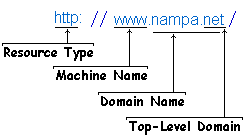The Internet Began As A Few Machines

The first networks connected people and resources within a company. This way, people could look at the same document from different desks or share printers.
Originally, this was done with mainframes. Back then, only large companies had computers. The advent of the Personal Computer (PC) changed everything. Today, it isn't unusual to find several computers in each home, and often a computer network.
The internet began to share and communicate between various networks. In order to accomplish this, each network needed to conform to a standard. Each resource (computer, web page, server, etc) was assigned an IP (internet protocol) address.
IP addresses take the form "###.###.###.###", where each ### represents a number between 0-255. These numbers are carefully assigned and controlled. This adds up to more than 4 billion IP addresses (IPv4).
What is a Domain Name?
Domain names really are the stars of the internet. People remember internet domain names much better than IP addresses. Each domain name is unique and can only be owned by one person (or company). If it's available on the domain registry, you can buy that domain name. If it isn't, but you want it bad enough, you could buy it from the current owner. Buying domain names from the domain registry is much cheaper than buying domain names from the current owner (like the game of monopoly).
IP addresses are tracked through DNS (domain name service). DNS servers collectively keep track of every resource on the internet through an heirarchical database system.
Humans tend to remember domain names
better than IP addresses
For instance:
Wouldn't it be great if each number was replaced with a name? Well, that's what domain names are all about. Humans remember the domain names of sites while DNS translates those domain names into the IP addresses that computer networks know and love so much.
Domain Name Structure
The following diagram shows the structure of a domain name. The top-level domain includes .com, .net or any of the standard country top-level domains like .us (United States) or .ca (Canada). New top-level domains (TLD) are being created all the time.

|
Top-Level Domains (examples)
|
- Resource Type
- The type of page. Typical web pages are HTTP, an acronym for 'Hyper Text Transfer Protocol'. HTTPS is secure HTTP. Other resources include, FTP, GOPHER, TELNET etc.
- Machine Name
- This can also be called a sub-domain. Most web pages start with WWW. This isn't an absolute rule. We could call it MYWEBSITE instead. Historically, people have chosen WWW (World Wide Web). You don't need to use this part on most web pages if the DNS is set up properly.
- Top-Level Domain
- The top level domain is a huge group of similar types of domain names. Some are restricted to only certain people, like .gov or .int.
- Domain Name
- The Domain Name, which includes the top-level domain name is the complete name, owned by someone (like you)!
Reading the Domain Name
You may occasionally see some other combined top-level domains like .co.uk or .co.jp which are actually a commercial domains in the United Kingdom or Japan.
Spotting the domain name isn't too difficult. Following the double-slash after the resource-type (http://), look for the very next slash. The domain is the text immediately before the slash. If no slash, then just the end. Everything after the slash, is directories on the domain name.
For example:
www.google.co.jp
www.bing.com/useful/stuff
www.google.com.greatstuff.evilscam.com/
192.168.0.100/www.google.com/
Note that the actual domain name is in bolded text. Many of the newer browsers are starting to do the same thing to help you determine the proper domain name.
Notice in the final 2 examples, you may spot the google.com, but really these addresses are trying to fool you. The EvilScam.com domain might be a real problem instead of what you are looking for. The IP (192.168.0.100) could also be a problem, especially if it claims to be your bank. Since domain names are so cheap, your bank should be able to afford one.
Many of the new browsers are starting to highlight the actual domain name of a web site. This is for your protection against identity theft and phishing attempts.